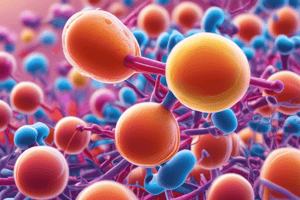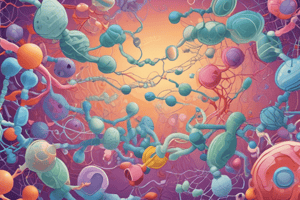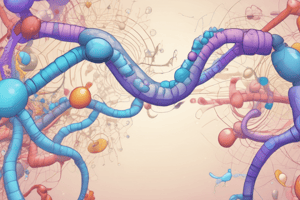Podcast
Questions and Answers
Which of the following protein synthesis inhibitors irreversibly binds to the 30S ribosomal subunit?
Which of the following protein synthesis inhibitors irreversibly binds to the 30S ribosomal subunit?
- Aminoglycosides (correct)
- Chloramphenicol
- Tetracycline
- Macrolides
Chloramphenicol has a broad spectrum of activity against both gram-positive and gram-negative bacteria.
Chloramphenicol has a broad spectrum of activity against both gram-positive and gram-negative bacteria.
True (A)
What type of medical condition is tigecycline primarily used to treat?
What type of medical condition is tigecycline primarily used to treat?
complicated intra-abdominal infections
The MLS group mainly targets __________ and some gram-negative bacteria.
The MLS group mainly targets __________ and some gram-negative bacteria.
Match the following examples of protein synthesis inhibitors with their appropriate categories:
Match the following examples of protein synthesis inhibitors with their appropriate categories:
What is the primary difference between sterilization and disinfection?
What is the primary difference between sterilization and disinfection?
A bacteriostatic agent is one that actively kills bacteria.
A bacteriostatic agent is one that actively kills bacteria.
What are the two main types of antimicrobial agents?
What are the two main types of antimicrobial agents?
The autoclave operates at a pressure of _____ psi and a temperature of _____°C.
The autoclave operates at a pressure of _____ psi and a temperature of _____°C.
Match the following methods with their correct descriptions:
Match the following methods with their correct descriptions:
What is the primary function of sulfonamide?
What is the primary function of sulfonamide?
Trimethoprim works independently and does not require constant drug levels to be effective.
Trimethoprim works independently and does not require constant drug levels to be effective.
What effect do increased concentrations of thymine have on the efficacy of folic acid inhibitors?
What effect do increased concentrations of thymine have on the efficacy of folic acid inhibitors?
The common names for the combination of sulfonamide and trimethoprim are _______ and _______.
The common names for the combination of sulfonamide and trimethoprim are _______ and _______.
Match the following mechanisms with their descriptions:
Match the following mechanisms with their descriptions:
Which of the following is a common example of intrinsic resistance?
Which of the following is a common example of intrinsic resistance?
What is β-lactamase's role in antimicrobial resistance?
What is β-lactamase's role in antimicrobial resistance?
Biofilms can contribute to antimicrobial resistance.
Biofilms can contribute to antimicrobial resistance.
Which antimicrobial category is reported first in susceptibility testing?
Which antimicrobial category is reported first in susceptibility testing?
Antimicrobial susceptibility testing (AST) is always required for every bacterium.
Antimicrobial susceptibility testing (AST) is always required for every bacterium.
What is the purpose of antimicrobial stewardship?
What is the purpose of antimicrobial stewardship?
The testing method that utilizes a disc to measure the growth inhibition of antimicrobial agents is called __________.
The testing method that utilizes a disc to measure the growth inhibition of antimicrobial agents is called __________.
Match the following patients with antimicrobials that are not reported due to adverse side effects:
Match the following patients with antimicrobials that are not reported due to adverse side effects:
When would a secondary agent be reported in AST?
When would a secondary agent be reported in AST?
What temperature and time are standard for incubating organisms during AST?
What temperature and time are standard for incubating organisms during AST?
Flashcards
Sterilization
Sterilization
The complete destruction of all forms of microbial life, including spores.
Disinfection
Disinfection
Reduction in the number of microorganisms, but not necessarily all.
Autoclave
Autoclave
A device using steam under pressure to sterilize objects, commonly used in labs.
Antimicrobial agent
Antimicrobial agent
Signup and view all the flashcards
Antibiotic
Antibiotic
Signup and view all the flashcards
Aminoglycoside mechanism
Aminoglycoside mechanism
Signup and view all the flashcards
Chloramphenicol mechanism
Chloramphenicol mechanism
Signup and view all the flashcards
Aminoglycoside side effects
Aminoglycoside side effects
Signup and view all the flashcards
Glycylcycline mechanism
Glycylcycline mechanism
Signup and view all the flashcards
MLS group spectrum
MLS group spectrum
Signup and view all the flashcards
Folic acid synthesis enzymes
Folic acid synthesis enzymes
Signup and view all the flashcards
Sulfonamide's mechanism
Sulfonamide's mechanism
Signup and view all the flashcards
Trimethoprim's mechanism
Trimethoprim's mechanism
Signup and view all the flashcards
Synergy of Sulfonamide & Trimethoprim
Synergy of Sulfonamide & Trimethoprim
Signup and view all the flashcards
Folic acid inhibitors - broad spectrum
Folic acid inhibitors - broad spectrum
Signup and view all the flashcards
Thymine and folic acid inhibitors
Thymine and folic acid inhibitors
Signup and view all the flashcards
Intrinsic resistance - vertical transmission
Intrinsic resistance - vertical transmission
Signup and view all the flashcards
Acquired resistance - exogenous DNA
Acquired resistance - exogenous DNA
Signup and view all the flashcards
Why is AST Sometimes Not Needed?
Why is AST Sometimes Not Needed?
Signup and view all the flashcards
When is AST Needed for Predictable Bacteria?
When is AST Needed for Predictable Bacteria?
Signup and view all the flashcards
How are AST Results Reported?
How are AST Results Reported?
Signup and view all the flashcards
What are Groups A, B, and C Antibiotics?
What are Groups A, B, and C Antibiotics?
Signup and view all the flashcards
Antimicrobial Stewardship
Antimicrobial Stewardship
Signup and view all the flashcards
What are Common AST Methods?
What are Common AST Methods?
Signup and view all the flashcards
What are the Key Requirements for Standard AST?
What are the Key Requirements for Standard AST?
Signup and view all the flashcards
Study Notes
Microbial Growth and Control
-
Microbial growth and control are covered in Chapters 10-11 of Bailey and Scott's and Chapters 12-13 of Diagnostic Microbiology.
-
The lecture covers:
- Methods of disinfection and sterilization used in clinical microbiology.
- Antimicrobial agents used clinically, focusing on mode of action and efficacy.
- Antimicrobial sensitivity testing methods (agar dilution, broth dilution, modifications to routine AST, and common supplementary testing).
- Screening tests for MRSA, VRE, ESBL, and CPE.
Disinfection vs. Sterilization
- Sterilization destroys all life forms.
- It's an all-or-nothing process.
- Disinfection eliminates certain microbes.
- Disinfectants are chemical agents used on inanimate objects.
- Antiseptics are substances used on living tissue to reduce bacteria.
Types of Microorganisms and Resistance to Killing
- Prions are the most resistant to killing.
- Bacterial spores are also very resistant.
- Mycobacteria are highly resistant.
- Nonlipid viruses come next.
- Fungi are less resistant than mycobacteria.
- Bacteria are less resistant than fungi.
- Lipid viruses are the least resistant.
Methods of Disinfection/Sterilization
- Physical methods:
- Heat (dry or moist including boiling and pasteurization).
- Filtration.
- Radiation.
- Lyophilization.
- UV.
- Chemical methods:
- Alcohols (50-70%).
- Aldehydes.
- Halogens.
- Heavy Metals.
- Detergents.
- Phenolics.
- Gases.
The Autoclave
- Typical specifications: 15 psi pressure, 121°C temperature, 15-20 minutes time.
- Destroys vegetative microorganisms, bacterial endospores, and viruses.
Chemical Agents Commonly Used as Disinfectants and Antiseptics
- Table details various agents, their actions, and clinical applications.
Antimicrobial Agents
- Organisms are killed or inhibited by substances.
- Antimicrobial agents are natural or synthetic substances targeting organisms.
- Antibiotics are purified from other microbial organisms.
- Bacteriostatic agents inhibit bacterial growth.
- Bactericidal agents typically kill the organism.
Antimicrobial Mode of Action
- Targets include cell wall, cell membrane, DNA/RNA synthesis, protein synthesis, and metabolic pathways.
Antimicrobial Mode of Action (Structural Integrity)
- Interfering with cell wall structure, cell membranes, essential metabolites, and nucleic acid synthesis.
Antibacterial Agents-Organization by Mode of Action
- Categorized by their mechanism of action, including cell wall, protein synthesis, genetic materials, cell membranes, and metabolic pathways.
Inhibition of Bacterial Cell Wall Biosynthesis
- Specific enzymes are crucial in building and shaping bacterial cell walls.
- These enzymes are called penicillin-binding proteins (PBPs).
- Drugs interfere with these essential enzymes.
The Cell Envelope Structure of Gram-Positive and Gram-Negative Bacteria
- Diagrams illustrating the structures of Gram-positive and Gram-negative bacteria.
B-Lactam Antibiotics
- Contain a four-membered ring.
- Inhibit transpeptidation.
- Pass through bacterial cell walls to reach target binding proteins (PBPs).
B-Lactam Antibiotics (Classes and Categories)
- Detailed table outlining classes and categories of b-lactam antibiotics, penicillin, cephalosporins, carbapenems , and monobactams.
Glycopeptides
- Bind to the end of the peptidoglycan, affecting transpeptidation.
- Inhibit cell wall synthesis and growth.
- Large molecules with limited penetration of gram-negative cell walls.
- Examples include vancomycin.
Cell Membrane Inhibitors - Polymyxin
- Act similar to detergents, causing increased permeability.
- Macromolecules and ions leak across the membrane leading to cell death.
- Examples are polymyxin B and colistin.
Protein Synthesis Inhibitors
- Target 30S or 50S ribosomal subunits.
- Disrupt cellular metabolism.
- Includes aminoglycosides, MLS group (macrolide-lincosamide-streptogramin), ketolides, oxazolidinones, streptogramins, chloramphenicol, tetracyclines, and glycylcyclines.
Aminoglycosides
- Bactericidal agents that bind to 30s subunit.
- Prevent tRNA docking.
- Cause misreading of the genetic code and risk for serious toxic effects.
- Examples include gentamicin, tobramycin, streptomycin, and kanamycin.
Chloramphenicol
- Bactericidal agent targets 50s subunit
- Prevents aminoacyl-tRNA docking
- Risk of aplastic anemia.
Glycylcyclines
- Higher affinity to 30S ribosomal subunit compared to Tetracyclines.
- Increased effectiveness against tetracycline-resistant organisms.
- Examples of one kind is Tigecycline.
Macrolide-Lincosamide-Streptogramin (MLS) Group
- Mostly effective against gram-positive bacteria, some gram-negative.
- Bacteriostatic or bactericidal depending on concentration.
- Includes erythromycin, azithromycin, clarithromycin, clindamycin, quinupristin/dalfopristin.
Oxazolidinones
- Binding to 50S subunit blocking initiation and translocation.
- Side effects include risks for serious hematologic and neurologic toxicity.
- Examples: Linezolid.
Tetracyclines
- Bacteriostatic.
- Reversible binding to 30S subunit.
- Inhibit rotation of bound tRNA into A-site
- Broad-spectrum, targets intracellular pathogens, Mycoplasma, and spiral bacteria like Borrelia, and Vibrio cholerae.
Inhibitors of DNA/RNA Synthesis
- Metronidazole: Nitroimidazole antibiotic.
- Effective against anaerobic infections.
- Activated under low redox potential conditions by reduction in the bacterial cytoplasm.
- Quinolones: Inhibit DNA gyrase and topoisomerase IV.
- Broad-spectrum antimicrobial agents.
- Examples include ciprofloxacin, levofloxacin, and moxifloxacin.
- Rifamycin: Binds to DNA-dependent RNA polymerase, inhibiting RNA synthesis.
Metabolic Inhibitors
- Sulfonamides: Inhibit dihydropteroate synthase in the folic acid pathway.
- Trimethoprim: Inhibit dihydrofolate reductase (DHFR) in the folic acid pathway.
Using Sulfonamide and Trimethoprim in combination
- Offers a synergistic effect.
- Provides broader spectrum of activity against enteric bacteria.
Increased Concentrations of Thymine
- Can lead to circumventing the effects of folic acid inhibitors
Antimicrobial Resistance Mechanisms
- Intrinsic resistance: Naturally present in bacteria's genome.
- Acquired resistance: Gained through exogenous DNA.
- Mechanisms can include enzymatic inactivation, altered target sites, decreased uptake of the drug, or increased efflux pumps.
Possible Causes for Antimicrobial Resistance
- Lack of affinity.
- Impermeability of the drug to enter the bacterial cell.
- Removal of the drug by chromosomally encoded efflux pumps.
- Innate production of antibiotic-inactivating enzymes.
- Biofilms (communities of bacteria that are irreversibly attached to a solid surface).
Enzymatic inactivation of Antimicrobials
- Some bacteria produce enzymes that destroy the drug before it reaches its target.
- B-lactamases are a common example in beta-lactam resistance.
B-Lactamase Inhibitors
- Share structural similarity to beta-lactam antimicrobials.
- Act to bind beta-lactamase enzymes, allowing other beta-lactam agents to exert their activity.
- Examples include sulbactam, clavulanate, tazobactam, and avibactam.
Efflux
- Involve efflux pumps.
- Proteins that transport molecules out of the bacterial cells.
Biofilms
- Sessile bacterial communities.
- Irreversibly attached to a solid surface.
- Embedded in an exopolysaccharide matrix.
- Highly resistant to antimicrobial agents.
- Resistance is determined by chemical and physical characteristics of biofilm formation, not typically acquired genetic mechanisms.
Resistance to Beta-Lactam Drugs (Gram Positive and Negative)
- Gram-positive resistance involves altered PBP targets and beta-lactamase production.
- Gram-negative resistance involves altered PBP targets and decreased drug uptake.
Resistance Mechanisms for Other Antimicrobials
- Resistance to other antimicrobials includes enzymatic destruction, altered target, decreased uptake, and efflux modifications.
Antimicrobial Susceptibility Testing (AST)
- Performed on bacteria and fungi isolated from clinical specimens.
- Used to determine effectiveness of antimicrobials.
- Methods include disk diffusion and dilution methods.
- Based on standards published by Clinical and Laboratory Standards Institute (CLSI).
- Important considerations include the body site, the presence of other organisms in the specimen, and the need to differentiate pathogens from normal flora.
Antimicrobial Susceptibility Testing (AST) Indications
- There is a probable cause to suspect an isolate is involved in a patient infection.
- The susceptibility against a particular antimicrobial is uncertain.
- Not performed on organisms known to be predictably susceptible.
- Example: Group A strep is considered universally susceptible to penicillin.
AST – Factors to Consider
- Body site, presence of other organisms, quality of specimen, host status (patient allergies, use of bactericidal or bacteriostatic agents).
AST - Choice of Antimicrobials
- Test batteries are utilized based on the type of organism.
- The Clinical and Laboratory Standards Institute (CLSI) recommendations are followed.
- The institutional pharmacy and therapeutics committee sets the list of drugs.
- Gram positive and gram negative susceptibility testing battery.
Categorization of Bacteria According to Need for Routine Performance of AST
- Categorized as commonly required, occasionally required, and rarely required tests.
- Based on the assumption that isolates are clinically significant and standardized AST procedures.
AST – Reporting
- Reports start with narrow-spectrum drugs before secondary drugs.
- Categorization prevents confusion and over-prescription based on groups.
AST – Reporting Contraindications
- Cases involving pediatric patients and some pregnant patients require special consideration, as certain antimicrobials should not be used due to their adverse side effects.
- Examples include tetracyclines and fluoroquinolones in pediatric patients and pregnant women.
AST – Reporting Example
- Organisms are tested for multiple drug classes (A, B, C) but only a few are reported, based on groups.
AST-Antimicrobial Stewardship
- Focuses on appropriate antimicrobial use to limit the development of antimicrobial-resistant organisms.
- Interventions include drug selection, dosing, duration, and route of administration.
Antimicrobial Susceptibility Methods
- Categorization of methods for determining antimicrobial susceptibility (e.g., broth methods, agar methods).
- Broth methods use dilution techniques to determine the MIC (minimum inhibitory concentration).
- Agar methods include disk diffusion for determining zones of inhibition.
AST Standard Elements
- Organism in pure culture, and in logarithmic phase.
- Standard inoculum.
- Standard incubation (ambient air, 37°C, 24 hours).
- Standard media (e.g., Mueller Hinton Broth or Agar).
- Selection of antimicrobial agents.
- Quality control (e.g., McFarland Standard).
Broth-Macrodilution Tests
- Broth-based dilution method.
- Serial two-fold dilutions of antimicrobials.
- Determining MICs (minimum inhibitory concentrations).
Broth-Microdilution Tests
- Breakpoint panels using microtiter plates.
- Commercial systems.
- Fewer wells and samples.
Agar Dilution Test
- Agar plates with varying concentrations of antibiotics.
- Bacterial inoculum on the plates.
- Incubate to observe growth inhibition zones.
Disk Diffusion Test (Kirby-Bauer)
- Drug diffusion creates zone of inhibition.
- Pure culture, 0.5 McFarland Standard.
- Standard disks (6mm).
- Mueller Hinton media.
Agar method: Disk Diffusion Test (General Steps)
- Swab 0.5 McFarland suspension.
- Placement of disks containing different antibiotic concentrations.
- Incubation overnight in O2.
- Read zone sizes, determining susceptibility by comparison with established reference charts.
Agar method: Disk Diffusion Test (Result Interpretation)
- Analyze zone sizes.
- Relate to MIC or interpret using charts, to determine susceptible, intermediate, or resistant results.
Agar method: Disk Diffusion Test (Additional Considerations)
- Ensure purity of plates.
- Handling of certain species or modifications depending on organism type (e.g., using CO2 for streptococci or Haemophilus).
- Analyze for swarming colonies or improper plate setups.
Kirby Bauer tests (common modifications for various organisms)
MRSA Screen, VRE Screen, D-test, ESBL Screen, CPE Screen
Gradient Diffusion Test
Beta-Lactamase Tests
Studying That Suits You
Use AI to generate personalized quizzes and flashcards to suit your learning preferences.




